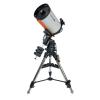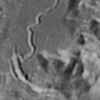Hello.
I use regularly a NV scope equipped with a second-hand gen III tube: MX10160 tube.
The tube works well but has a permanent "shadow or ghost image" in negative (shape of a window or a door ???) due I guess to a miss-use from the previous owner.
Such defect is not dramatic and I am used to observe sky or terrestrial landscape while forgetting that...
In extreme dark condition, such ghost pattern is by the way not noticeable at all.
But, I just read that said defect may be partially removed by using the "dark shoebox trick", which would basically consist in running the tube on, in a fully dark enclosure, during several days.
So, fake or truth?
If truth, what would be the physical mechanism behind this trick which would allow to (at least partially) "regenerate" the tube (its photocathode? its screen? both?)?
Did some of you try this trick and be successful? without any secondary drawback (for instance: finding back an homogeneous image, but at the cost of a loss of sensitivity?)
I am tempted to try that, but I have only this one gen III tube and being in Europa, I would not like to destroy it... Too expensive and hard to find them here... ![]()
If this "dark shoebox" trick is not clearly indicated as valid by you, I will simply keep on using and enjoying my tube according its current state.
In advance thank you for your feedback/advice on that.
Clear sky.
Lambda



















